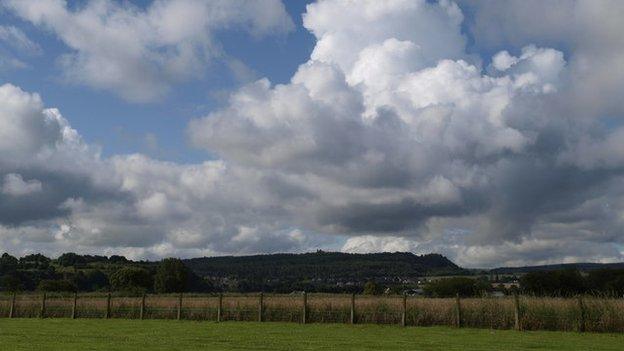Quarry plans for Battle of Bannockburn site dismissed
- Published

Gillies Hill is said to have played a pivotal role in the Battle of Bannockburn
Controversial plans to quarry for stone on the site of the Battle of Bannockburn have been thrown out by a Scottish government reporter.
Gillies Hill at Cambusbarron, near Stirling, played a decisive role in the 1314 battle, but much of the hill has already been quarried.
Operations ceased 20 years ago, but Patersons Quarries, of Coatbridge, wanted to resume.
After a public inquiry Reporter Richard Dent refused planning permission, external.
He said he had taken into account the "economic benefits" offered by the proposal but believed they were outweighed by its adverse impacts.
'Considerable doubt'
Mr Dent added that the Patersons Quarries proposal was contrary to planning policy, and there was "serious doubt" whether local roads could accommodate the increase in heavy traffic that the proposed development was likely to generate.
But he made it clear that his decision had nothing to do with Gillies' Hill's supposed role in the battle.
He said: "In respect of the Battle of Bannockburn there is considerable doubt about the role of Gillies Hill.
"However, even if the hill played a more central role... I do not consider that the development would have a significant impact on the understanding and interpretation of the battle."
Much of the quarry has existing planning permission, valid until 2042, but the site eyed up by Patersons included an area outside the existing workings.
Battlefield site
The application attracted 1,077 objections, including from Torbrex, Kings Park and Cambusbarron community councils, the Stirling Civic Trust, Stirling High School Parent Council and other local and national organisations.
Patersons appealed to the Scottish government after Stirling Council failed to determine a planning application.
The descent of the gillies on to the field of Bannockburn is seen as a turning point in the 1314 battle, in which Robert the Bruce defeated the English King Edward II.
According to legend, as the tide of battle swung in the Bruce's favour, the "Sma' Folk", or "gillies" - servants, cart drivers and camp followers who had been concealed behind the hill - swarmed down to finish the fight.
The English, thinking the rabble to be another regiment of Scots infantry, were further demoralised and fled in panic.
- Published25 June 2010